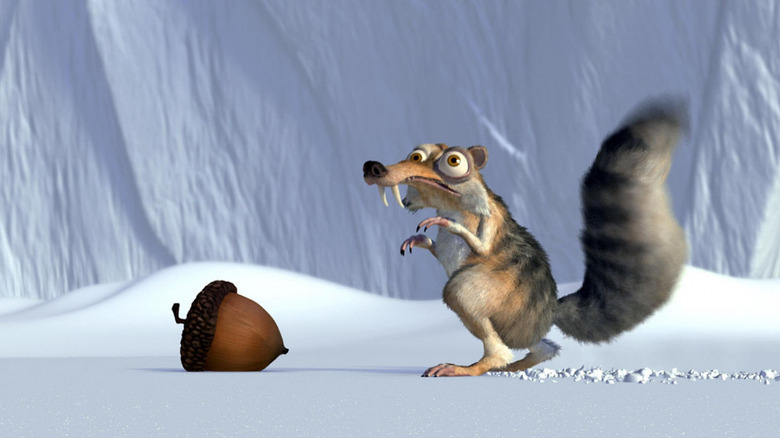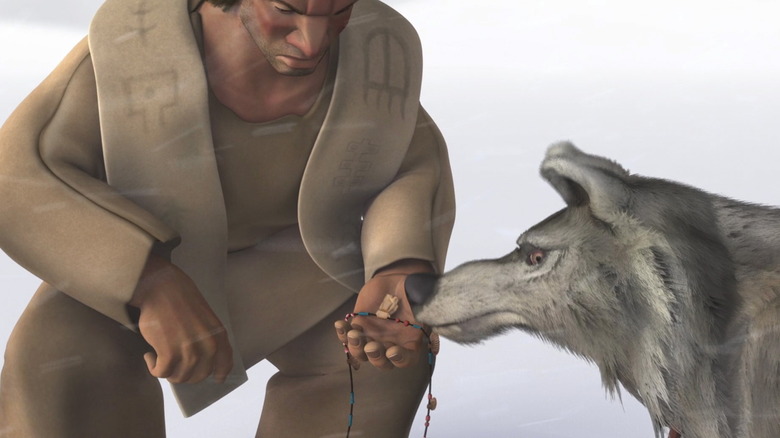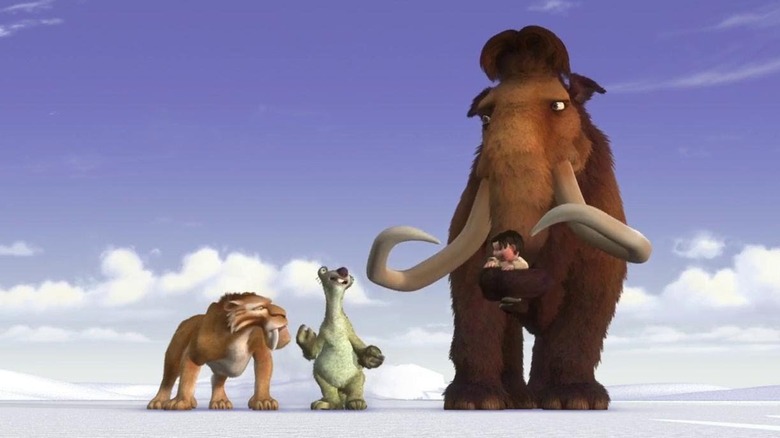Tales From The Box Office: How Ice Age Quietly Started A Multi-Billion Dollar Franchise
(Welcome to Tales from the Box Office, our column that examines box office miracles, disasters, and everything in between, as well as what we can learn from them.)
Sometimes, gigantic things have relatively humble beginnings. Such is the case with "Ice Age," a multi-movie, multi-decade franchise that launched Blue Sky Studios, generated billions at the box office, survived the Disney/Fox merger, and endures to this very day. Yet it all began with a simple, 81-minute animated adventure with lovable prehistoric animals and a lost human baby that did solid if not groundbreaking business, performing well enough to warrant a continuation. A continuation that, in the years since, has kind of quietly created one of the biggest animated franchises in existence.
In honor of the 20th anniversary of "Ice Age" this week, we are looking back at how the movie came about as a unique effort to save a VFX house under Fox's ownership, how much it evolved during the development process, and how the final product managed to become a big hit despite the circumstances seeming not at all in the movie's favor, as well as what lesson's can be learned from that success.
The movie: Ice Age
While there is always a lot of focus on franchises that have helped prop up Hollywood over the decades, with Marvel and DC's superheroes doing the lion's share of the work these days, it is at times easy to forget just how important and reliable animation can be to the industry at large. Heck, Disney is essentially built in its entirety on the back of "Snow White and the Seven Dwarfs." And "Trolls: World Tour" all but upended the movie business as we know it by being the first brand new movie to be offered to viewers from the comfort of home on premium VOD while also playing in theaters as the coronavirus pandemic was just getting underway. Animation drives a lot of innovation and box office dollars that make the movie business tick.
To that end, Fox didn't have a dedicated animation house in the late '90s. But they did have Blue Sky Studios, which had been working on VFX for movies such as "Alien: Resurrection" and "Fight Club." The moment for change came when the short "Bunny" was nominated for on Oscar, offering a window of opportunity for the animation house to make a feature. Fox, meanwhile, was considering selling Blue Sky by the year 2000, at a time when the visual effects industry was struggling. Instead, producer Lori Forte and one of the studio's founders, Chris Wedge, brought a script to the brass for a feature titled "Ice Age" written by Michael J. Wilson, and proposed having the studio make that movie instead. Speaking with Variety in 2008, Wedge recalled the terms Fox animation head Chris Meledandri gave them to proceed.
"It was an extraordinary script really and Meledandri said he would give it to us if we could turn it into a comedy. It was our one opportunity to do what we always wanted to do and prove to Fox that they shouldn't sell us."
So, Wedge was hired to direct along with Carlos Saldanha, with writers Michael Berg and Peter Ackerman brought on board to punch up the comedic elements of the script, which was originally envisioned as a traditional 2D animated feature with a more serious tone. Instead, it morphed into a comedy with heart that was fully computer-animated. With a cast led by Ray Romano as Manfred, Dennis Leary as Diego, and John Leguizamo as Sid, all of the pieces were in place for the movie that would go on to define Fox's hot streak in animation right up until the very end.
The financial journey
Working against a relatively small $59 million budget, "Ice Age" made its way to theaters on March 15, 2002. For all of Fox's lack of faith and for all of the changes this movie underwent to make its way to theaters, the studio was rewarded handsomely for its troubles. The family-friendly animated flick debuted to a quite good $46.3 million, which set it up for a nice run at the domestic box office, finishing with $176.3 million. Internationally, it performed even better, doing $206.8 million worth of business for a grand total of $383.2 million. Against that sort of budget, that was outstanding. It certainly didn't hurt that the movie also went on to earn an Oscar nomination for best animated feature.
These were damn good numbers, and certainly good enough to warrant a sequel. Blue Sky being afforded the chance to prove itself gave Fox a golden goose that ended up being responsible for billions of dollars at the box office over the next 17 years. The "Ice Age" franchise alone spawned four sequels, with the franchise in total taking in $3.2 billion, reaching its peak in 2012 with "Ice Age: Continental Drift," which pulled in a staggering $879 million against a $95 million budget, with $718 million of that money coming from overseas. That's downright incredible.
Blue Sky was also responsible for hits like "Rio" and "Ferdinand," taking in just shy of $6 billion all told by the time its last release, "Spies In Disguise," hit theaters in 2019. Unfortunately, that would be the end of the line for the studio, which was nearly batting 1,000 with only perhaps one true misfire in "Epic" to its name. Disney purchased Fox in 2019 and it was confirmed in February of 2021 that Disney intended to close the studio. Unfortunately, this all made sense given that Disney had its own animation shingles such as Pixar and Walt Disney Animation Studios to cover that ground. It was a sad end to a studio that started small and built itself up to become an utter pillar of an important part of the industry.
The lessons contained within
One of the biggest of the big lessons that can be learned here is to not let a good idea go. "Ice Age," on its own, was a solid hit that any studio would be happy to have, but it only came about as a result of a good script and the desire of passionate filmmakers to make it a reality. That passion, in turn, created one of the most reliable hit-making animation studios the industry had ever seen. This, despite the fact that Disney and DreamWorks all but had the market cornered at that time. To that end, Wedge, speaking in 2002, remarked on the challenge of trying to compete with those titans of the industry as an unproven entity at the time.
"I don't believe that anyone has a monopoly on good ideas. If you worry about what other people are doing you will lose focus on your own work. We pounded on 'Ice Age' for as long as we had time for and then we sent it out. We will do the same for the next one. We can't worry about competition. Besides, you aren't competing with anyone but yourself. They have nothing to do with whether you make a good movie or not."
As the media landscape continues to change, people are probably going to care less and less about who does what. It's really going to come down to who has the best thing that they want to watch. It wouldn't matter if Disney released "John Wick 4," people would still want to see it. Studios and the powers that be should be more open than ever to good ideas of any kind in an age when content is king. This is not to say that taking silly risks is the way to go, but Fox allowed "Ice Age" room to breathe while also being responsible about it, keeping the budget modest while not kneecapping the process.
In turn, Fox was rewarded greatly for this for nearly two decades. And now, it's Disney who stands to gain, with "The Ice Age Adventures of Buck Wild" debuting exclusively on Disney+ earlier this year, keeping the franchise going in an entirely new way, under a brand new roof. This doesn't happen with cold feet or being too concerned with brand identity. A good idea is a good idea, and when you allow the cream to rise to the top, good things happen.



